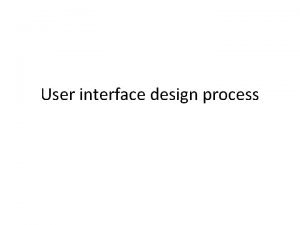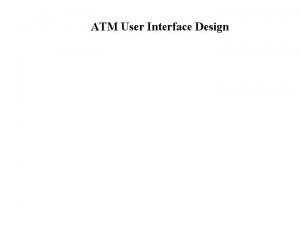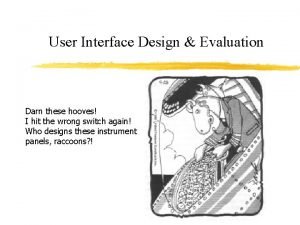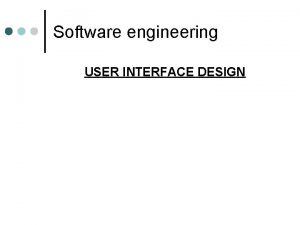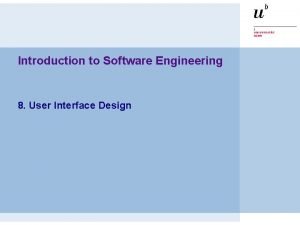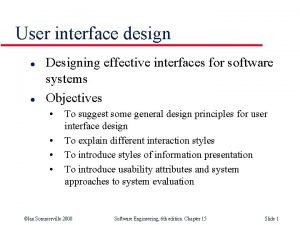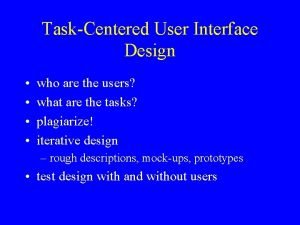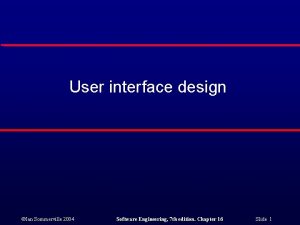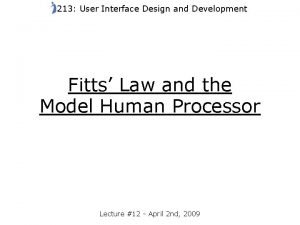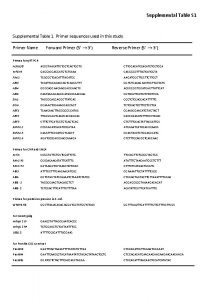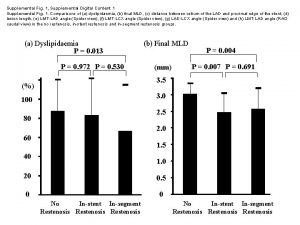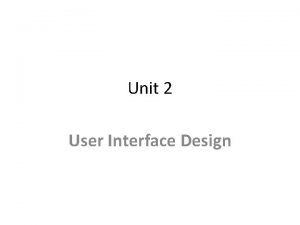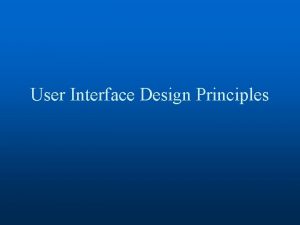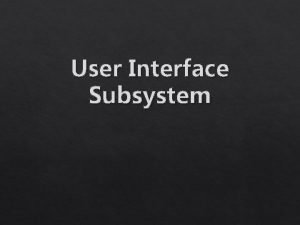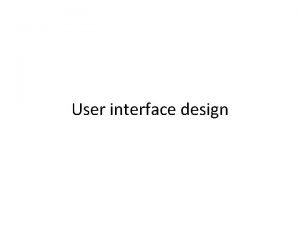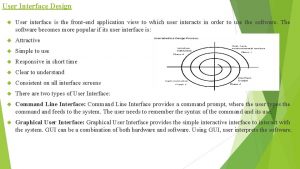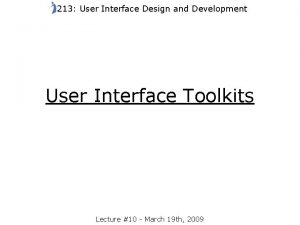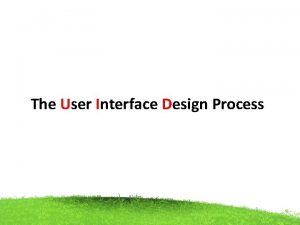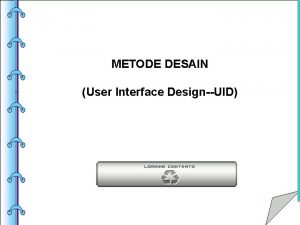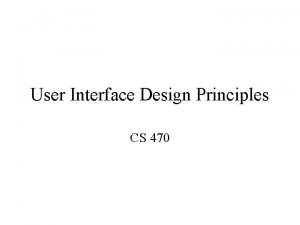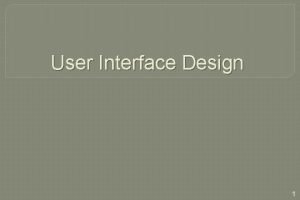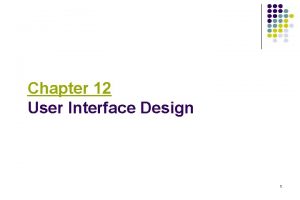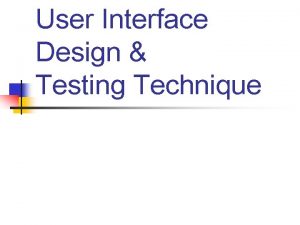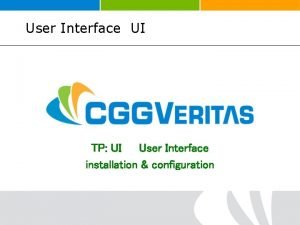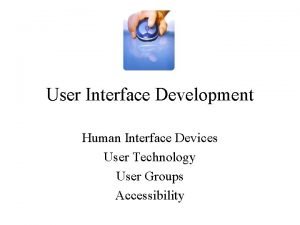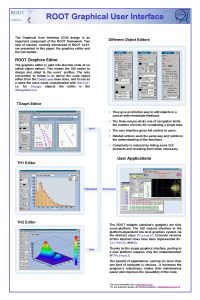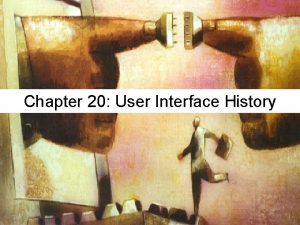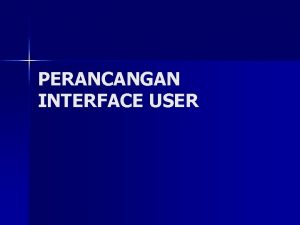6 supplemental User Interface Design User Interface Design




























- Slides: 28

6. (supplemental) User Interface Design

User Interface Design • System users often judge a system by its interface rather than its functionality • A poorly designed interface can cause a user to make catastrophic errors • Poor user interface design is the reason why so many software systems are never used

User-Centred design • User-centred design is an approach to UI design where the needs of the user are paramount and where the user is involved in the design process • UI design always involves the development of prototype interface

GUI advantages • They are easy to learn and use. – Users without experience can learn to use the system quickly. • The user may switch quickly from one task to another and can interact with several different applications. – Information remains visible in its own window when attention is switched. • Fast, full-screen interaction is possible with immediate access to anywhere on the screen

GUI Disadvantages • Variety of I/O choices can be confusing for developers and users • Various pop-up menus and windows can quickly become confusing • Choice of colors, textures, sounds, images requires graphic arts background

UI design principles • UI design must take account of the needs, experience and capabilities of the system users • Designers should be aware of people’s physical and mental limitations (e. g. limited short-term memory) and should recognise that people make mistakes • Not all UI design principles carry the same weight across all designs

Design principles • User familiarity – The interface should be based on user-oriented terms and concepts rather than computer concepts. For example, an office system should use concepts such as letters, documents, folders etc. rather than directories, file identifiers, etc. • Consistency – The system should display an appropriate level of consistency. Commands and menus should have the same format, command punctuation should be similar, etc. • Minimal surprise – If a command operates in a known way, the user should be able to predict the operation of comparable commands

Design principles • Recoverability – The system should provide some resilience to user errors and allow the user to recover from errors. This might include an undo facility, confirmation of destructive actions, 'soft' deletes, etc. • User guidance – Some user guidance such as help systems, on-line manuals, etc. should be supplied • User diversity – Interaction facilities for different types of user should be supported. For example, some users have vision difficulties and so larger text should be available

User-system interaction • Two problems must be addressed in interactive systems design – How should information from the user be provided to the computer system? – How should information from the computer system be presented to the user? • User interaction and information presentation may be integrated through a coherent framework such as a user interface metaphor or interaction style

Interaction styles • • • Direct manipulation Menu selection Form fill-in Command language Natural language

Interaction Style Advantages and Disadvantages

Information presentation • Information presentation is concerned with how sys. information is delivered to users • The information may be presented directly (e. g. text in a word processor) or may be transformed in some way (e. g. in some graphical form) • The Model-View-Controller approach is a way of supporting multiple presentations of data

Multiple User Interfaces via Model-View-Controller VIEW CONTROLLER MODEL

Information presentation • Static information – Initialised at the beginning of a session. It does not change during the session – May be either numeric or textual • Dynamic information – Changes during a session and the changes must be communicated to the system user – May be either numeric or textual

Information display factors • Is the user interested in precise information or data relationships? • How quickly do information values change? Must the change be indicated immediately? • Must the user take some action in response to a change? • Is there a direct manipulation interface? • Is the information textual or numeric? Are relative values important?

Alternative information presentations Textual Graphical

Colour displays • Colour adds an extra dimension to an interface and can help the user understand complex information structures • Can be used to highlight exceptional events • Common mistakes in the use of colour in interface design include: – The use of colour to communicate meaning – Over-use of colour in the display

Colour use guidelines • • Don't use too many colours Use colour coding to support use tasks Allow users to control colour coding Design for monochrome then add colour Use colour coding consistently Avoid colour pairings which clash Use colour change to show status change Be aware that colour displays are usually lower resolution

User support • User guidance covers all system facilities to support users including on-line help, error messages, manuals etc. • The user guidance system should be integrated with the user interface to help users when they need information about the system or when they make some kind of error • The help and message system should, if possible, be integrated

Help and message system

Error messages • Error message design is critically important. Poor error messages can mean that a user rejects rather than accepts a system • Messages should be polite, concise, consistent and constructive • The background and experience of users should be the determining factor in message design

Design factors in message wording

System and user-oriented error messages

Help information • Should not simply be an on-line manual • Screens or windows don't map well onto paper pages. • The dynamic characteristics of the display can improve information presentation. • People are not so good at reading a screen as they are text.

Help system windows

User interface evaluation • Some evaluation of a user interface design should be carried out to assess its suitability • Full scale evaluation is very expensive and impractical for most systems • Ideally, an interface should be evaluated against a usability specification. However, it is rare for such specifications to be produced

Usability attributes

Simple evaluation techniques • Questionnaires for user feedback • Video recording of system use and subsequent tape evaluation. • Instrumentation of code to collect information about facility use and user errors. • The provision of a grip button for on-line user feedback.
 User interface design in system analysis and design
User interface design in system analysis and design What is input design in system analysis and design
What is input design in system analysis and design Guidelines for data entry screen design
Guidelines for data entry screen design User interface design cycle
User interface design cycle User interface design steps in software engineering
User interface design steps in software engineering User interface analysis and design
User interface analysis and design Principles of user interface design
Principles of user interface design Uiecu
Uiecu Atm interface design
Atm interface design User interface design and evaluation
User interface design and evaluation Interface design in software engineering
Interface design in software engineering User interface design principles in software engineering
User interface design principles in software engineering Python user interface design
Python user interface design Visualization in user interface design
Visualization in user interface design Recoverability in user interface design
Recoverability in user interface design Interface analysis means understanding
Interface analysis means understanding Task centered user interface design
Task centered user interface design Interface design in software engineering
Interface design in software engineering Labview user interface design examples
Labview user interface design examples User interface design process in software engineering
User interface design process in software engineering Fitts law user interface design
Fitts law user interface design Supplemental tables
Supplemental tables Drop supplemental log group
Drop supplemental log group Tea blank graphic organizers
Tea blank graphic organizers Tea approved graphic organizers
Tea approved graphic organizers Staar blank graphic organizers
Staar blank graphic organizers Supplemental online coursework
Supplemental online coursework Mcas accessibility and accommodations
Mcas accessibility and accommodations What is ssi
What is ssi



